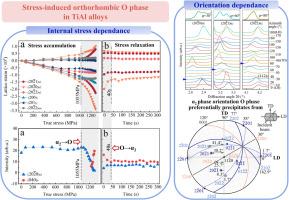Stress-induced orthorhombic O phase in TiAl alloys
IF 8.3
1区 材料科学
Q1 MATERIALS SCIENCE, MULTIDISCIPLINARY
引用次数: 0
Abstract
The orthorhombic O phase precipitation within the D019-α2 phase has attracted increasing attention recently in high Nb containing TiAl (high Nb-TiAl) alloys since the precipitation temperature is close to the expected service temperature of the alloys. In this study, in-situ synchrotron high energy X-ray diffraction (HEXRD) reveals that the O phase precipitates at 550 °C while it dissolves into the α2 phase at 750 °C during heat treatments. However, under external stress the O phase unexpectedly precipitates from α2 phase at 800 °C and even 900 °C. The O phase formation proceeds further in the presence of a critical stress promoted by internal stress accumulation in the α2 phase, whereas the reverse O→α2 phase transformation takes place when the internal stresses are relaxed. Additionally, it has been revealed that the O phase preferentially precipitates from specifically oriented α2 grains with one of their <110> directions aligned perpendicular and their 〈0001〉 directions rotated by an angle of 120° out of the external load axis. This α2 phase orientation facilitates the α2→O crystal transition during uniaxial compression. Transmission electron microscopy (TEM) study shows that stress-induced α2→O transformation is governed by small atomic shifts in the α2 lattice. In addition, the selective growth of certain O variants via shuffling along an [110]α2 direction is found to accommodate the external strain component in this direction.


TiAl合金中应力诱导的正交O相
在高铌TiAl(高铌TiAl)合金中,D019-α2相内的正交O相析出引起了越来越多的关注,因为析出温度接近合金的预期使用温度。原位同步高能x射线衍射(HEXRD)表明,在550℃热处理时,O相析出,750℃热处理时,O相溶入α2相。然而,在800℃甚至900℃的外部应力作用下,α2相意外地析出O相。α2相中积累的内应力促进了临界应力的存在,而当内应力松弛时,则发生了O→α2相的反向转变。此外,还发现O相优先从特定取向的α2晶粒中析出,其中一个为<;112¯0>;垂直方向及其<;0001>;方向旋转120°的角度外的外部负载轴。这种α2相取向有利于α2→O晶体在单轴压缩过程中的转变。透射电镜(TEM)研究表明,应力诱导的α2→O转变是由α2晶格中的小原子位移控制的。此外,发现某些O变异体沿着[112¯0]α2方向的洗牌选择性生长,以适应该方向的外部应变分量。
本文章由计算机程序翻译,如有差异,请以英文原文为准。
求助全文
约1分钟内获得全文
求助全文
来源期刊

Acta Materialia
工程技术-材料科学:综合
CiteScore
16.10
自引率
8.50%
发文量
801
审稿时长
53 days
期刊介绍:
Acta Materialia serves as a platform for publishing full-length, original papers and commissioned overviews that contribute to a profound understanding of the correlation between the processing, structure, and properties of inorganic materials. The journal seeks papers with high impact potential or those that significantly propel the field forward. The scope includes the atomic and molecular arrangements, chemical and electronic structures, and microstructure of materials, focusing on their mechanical or functional behavior across all length scales, including nanostructures.
 求助内容:
求助内容: 应助结果提醒方式:
应助结果提醒方式:


